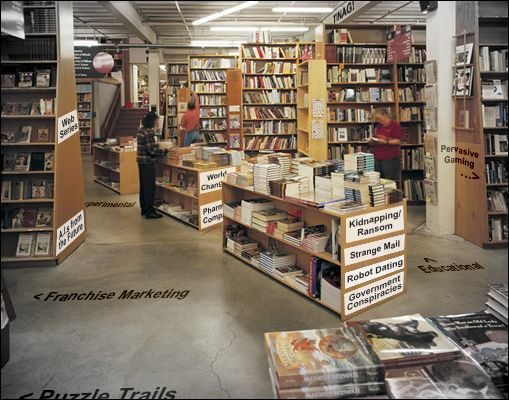
The past few days have seen an increase in discussion of labels and content production due to the PGA officially recognizing “Transmedia Producer” in the Producer Code of Credits. But what is “transmedia”, and is their definition of a Transmedia Producer an accurate representation of the people who claim to ‘produce transmedia’? In the midst of this hot topic, however, another caught my eye – Rowan72 tweeted a challenge for ARG creators:
Create an ARG where the missing friend is found and/or the mysterious journal is explained – AT THE BEGINNING OF THE GAME.
Labfly expanded:
and then players realize they shouldn’t have found the journal or friend and they must spend the rest of the ARG plotting and executing re-vanish
It may have been a bit tongue in cheek, but the challenge is a sincere one. Rowan followed up by posing the age old question:
Why does it seem like the majority of games are about finding the missing person or explaining the mysterious thing?
Maureen McHugh of NoMimes Media raises the point in Storytelling and the Illusion of Authenticity that “the stories seem most effective when the plot of them is rather conventional”. We do tend to find these days that many ARGs are telling the same stories – just with different characters and different places.
Rowan’s concern reminded me very much of Rob Paravonian’s Pachelbel Rant:
The ARG ‘formula’ is getting so saturated with copycat conventions that it’s like walking into a book store and having to skip the genres we don’t like, heading straight to our favourite aisles. But even in the midst of all the noise, occasionally one book may stand out, a best-seller perhaps, and we curiously dive in. Why?
These are the games that, as Rowan later put it, have “personality”. The ones that stand out from their neighbours in some way. Or, as Maureen also wrote:
The audience needs some level of comfort and some elements of surprise. For now, Transmedia is pretty much always surprising for the audience
Just as with novels, there a couple of major factors to take into creative consideration: Plot formula (eg, rescue the kidnapped girl), and content personality (are the characters lovable and unique so that people connect with them?). If neither are up to par, chances are it will get pushed to the back of the shelf, perhaps picked up a few times, but mostly put back to gather dust. But if either factor attracts attention, there’s a much better chance it’ll start flying off the shelves. If something catches our curiosity, it may cause us to accept the parts we’re not as excited about, and end up having a great experience anyway
There will, however, always be an audience for the ‘rehash’, stories and games using the same old safe conventions. The “OMG help! My friend is missing!” for one, is on track to become a “cheesy romance novel” of ARGs. Everyone has their likes and dislikes, and that’s great! But I think, if we want to evaluate this form of entertainment and engagement, we have to stop looking at this creative method (ARGs, Transmedia, pervasive gaming, ‘insert-name-here’) on the whole where every item effectively defines the genre in some way, and rather come at it with more of a bookstore mentality.
Just as novels will never disappear, ARGs and transmedia storytelling are here to stay. As its sphere of influence and visibility grows, we’ll be seeing more of this mentality. Our bookstore layout is changing year after year, even month after month while we try to organize the aisles with appropriate categories – it’s growing and expanding at an exponential rate. It will be filled with endless genres and variants and labels. It’ll be filled with best-sellers and dust-gatherers, novels and videos, fiction and non-fiction, education and entertainment, reference and religion. It will have new releases, and newspaper archives. There will be special events and games taking place in its doors. It’ll attract old and young, rich and poor, window shoppers, lurkers, and buyers. It will house promotions, contests, and community events. There may even be book signings. Our bookstore is a thriving location for creatives and community. It could even take the form of a library where rather than providing only one-time purchases, items can be checked out and experienced repeatedly by many.
We can’t gauge the overall state of “Books”, but we can certainly see trends and we can survey book enthusiasts in efforts to drill down and analyze the latest and greatest. Novelists don’t define “Books” either, that’s rather redundant – they simply create content in their style which attracts a certain target audience, and their novel naturally finds a place in some aisle (or may potentially even find a place in multiple). An unsuccessful novel doesn’t indicate that books are dying out, nor its genre, and neither should unsuccessful transmedia productions have a negative defining effect. We’re at the point now in this industry that everything that has been created will be created again – the aisles will expand, being populated with non-unique productions, rehashes and copycats, utilizing tried and true conventions – and they’ll still have an audience. But it’s the first movers and innovators that are the ones pushing for new subject aisles and categories entirely, the ones that seek to expand the selection within the bookstore.
What we’re on the verge of right now is breaking out of the ‘aisle’ mentality. Other industries look over here and see creators debating about the subject and what the aisle should be labeled, rather than being guided to what they’re looking for. They see some separate out to make their own aisle, sometimes for exposure and 15 minutes of fame, but usually because the creator realized what they’ve created or want to create seems out of place in our aisle or they felt limited by its particular definition and is better suited elsewhere, under some other new label. Additionally, if someone looking to break into this creative community generates a project that doesn’t quite fit the current label or fails outright, they’re left in the cold as some undefined independent ‘thing’ because accepting it into our subject aisle means the others are condoning something that doesn’t quite represent accurately what our aisle’s about, and that’s a bad thing because we’re still trying to define our aisle. Then the other industries are drawn to wherever the popular buzz of activity is, like moths to a flame, and we wonder why they don’t get it.
If we embrace the bookstore mentality, we’ll be able to expand and collectively accept the growing repertoire of styles and methods. Subject aisles become collections of similar ideas and implementations without a sense of inherent ownership of the label or method. It doesn’t by any means limit the potential or scope of creative productions, but rather encourages a more positive perception as this industry evolves. There will be a place for everyone in its doors. It’ll have projects we don’t really like, and some we love, plus many we’ve never even heard of because we can’t keep up with everything that’s being created. Stories and games will be created and they may sneak into an aisle with no warning, but it won’t matter – because someone will still come across it and be interested in it. It’ll be easier to freely create, and whether it’s free entertainment or marketing, rehash or completely new, there will always be an audience, and the cream of the crop will rise to the top as the best-sellers, regardless.
We want more best-sellers! We want writers and creators who challenge our thinking, who create unique, memorable, refreshing experiences. But love it or hate it, there will always be someone posting to a blog begging for people to help them rescue their kidnapped friend — the cheesy romances are here to stay.

